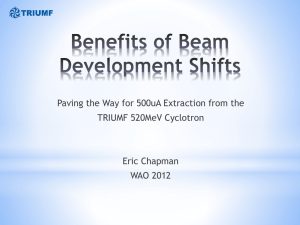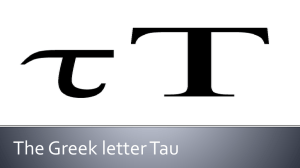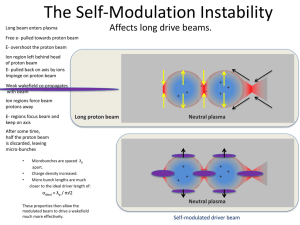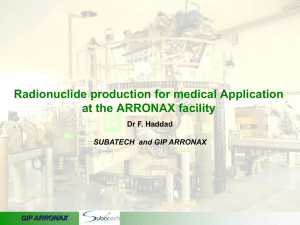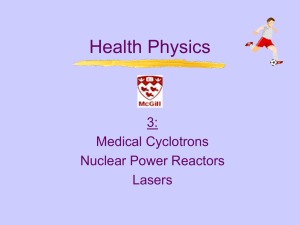Cyclotron ARRONAX
advertisement
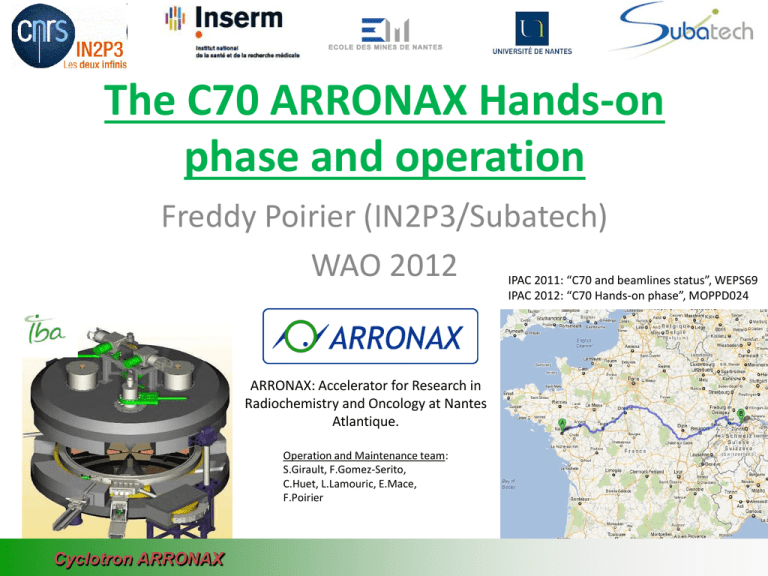
The C70 ARRONAX Hands-on phase and operation Freddy Poirier (IN2P3/Subatech) WAO 2012 IPAC 2011: “C70 and beamlines status”, WEPS69 IPAC 2012: “C70 Hands-on phase”, MOPPD024 ARRONAX: Accelerator for Research in Radiochemistry and Oncology at Nantes Atlantique. Operation and Maintenance team: S.Girault, F.Gomez-Serito, C.Huet, L.Lamouric, E.Mace, F.Poirier Cyclotron ARRONAX Historical Background Inauguration in 2008 24h tests in 2010 750 mA 24 h Machine reception (2010) and handson phase phase (2011-12) • October 2008 : Inauguration • March 2010: Low intensity Irradiation • October 2010: 24h at 750 pmA on beam dumps • Dec. 2010: Final machine reception • 2011-12: Hands-on phase with an extended program on tuning and exploration of beam parameters for users. ARRONAX goal • A tool to produce radionucleides for research in nuclear medecine – – • Imaging: + radioelements for PET (ex: 82Sr/82Rb, 44m/44Sc, 52Fe, 64Cu ...) Therapy: immunotherapy (211At), - radioelements : 67Cu, 47Sc un outil pour la recherche en radiochimie – notamment radiolyse alpha de l’eau (stockage des déchets nucléaires) Radioelement for therapy • un outil pour la recherche en Physique Target irradiation – notamment étude des matériaux sous rayonnement Particles Beam Production of radioelements – Développement de système de détection In the target by transmutation – Mesures de données nucléaires Acceleration • un outil pour la formation – Université de Nantes – École des mines de Nantes – CHU de Nantes – Radioactive Formation continue • Tomographic imaging of the heart Chimical extraction Separation Purification Marking medical un site de production industrielle pour les besoins médicaux element (experimental) Cyclotron ARRONAX 99Tc-MIBI SPECT 82Rb-PET ARRONAX goal • A tool to produce radionucleides for research in nuclear medecine – – • Imaging: + radioelements for PET (ex: 82Sr/82Rb, 44m/44Sc, 52Fe, 64Cu ...) Therapy: immunotherapy (211At), - radioelements : 67Cu, 47Sc A tool for radiochimistry/radiobiology research – notably alpha radiolyse of water (eg nuclear waste storage) • un outil pour la recherche en Physique – notamment étude des matériaux sous rayonnement – Développement de système de détection – Mesures de données nucléaires • un outil pour la formation – – – – • Université de Nantes École des mines de Nantes CHU de Nantes Formation continue un site de production industrielle pour les besoins médicaux Cyclotron ARRONAX ARRONAX goal • A tool to produce radionucleides for research in nuclear medecine – – • Imaging: + radioelements for PET (ex: 82Sr/82Rb, 44m/44Sc, 52Fe, 64Cu ...) Therapy: immunotherapy (211At), - radioelements : 67Cu, 47Sc A tool for radiochimistry/radiobiology research – notably alpha radiolyse of water (eg nuclear waste storage) • A tool for physics research – Particularly studies of material under irradiation – Development of detection system – Measurements of nuclear data • Experience « Stacked Foils » Cross section measurements: exemple from 17 to 69 MeV- (100 nA) un outil pour la formation – Université de Nantes PIXE - –Particle Induced X-ray Emission École des mines de Nantes - Non destructive Caracterisation Method – CHU de Nantes – Formation continue quantitative of multielements material, - Dvt of mesuring bench un site de production industrielle pour les besoins médicaux - •( ~nA) Ti naturel + p 43Sc + X Cyclotron ARRONAX ARRONAX goal • A tool to produce radionucleides research in nuclear medecine – – • Imaging: + radioelements for PET (ex: 82Sr/82Rb, 44m/44Sc, 52Fe, 64Cu ...) Therapy: immunotherapy (211At), - radioelements : 67Cu, 47Sc A tool for radiochimistry/radiobiology research – notably alpha radiolyse of water (eg nuclear waste storage) • A tool for physics research – Particularly studies of material under irradiation – Development of detection system – Measurements of nuclear data • A tool for training and education – – – – • University of Nantes École des mines of Nantes CHU (accademic hospital) of Nantes Permanent and dedicated trainings An industrial production site for medical needs Cyclotron ARRONAX • • C70 Cyclotron build by IBA: Characteristics Extracted Energy Highest – Isochron cyclotron with 4 sectors range possible Particles current • RF: 30.45 MHz (MeV) (µAe) • Acceleration Voltage: 65 kV H+ 30 - 70 375 x 2 • Max magn. field : 1.6T He2+ 70 70 HH+ 35 50 – ~4m of diameter D+ 15 - 35 50 – Max kinetic energy/n: 30-70 MeV – Normalised emittance before extraction: gex=~4p mm mrad (simulation) most common current range (µAe) 0.05 – 80 x 2 0.07 – 0.1 0.1 – 1 0.05 – 1.2 Nb of particles / bunch at 1 µAe 205 103 102 103 410 103 205 103 Main additional elements: – 2 Multiparticle sources. • Multicusp (H-,D-) with multiple magnets, 5mA max. • Supernanogan ECR ion source (He2+,HH+) – Injection: Series of magnetic elements (glaser, steerer, quad.) on the top of the cyclotron to adapt the beam to the entrance of the cyclotron, and finally the spiral inflector – Extraction: stripper (-) or electrostatic deflector (+) 2 strippers: carbon He2+, HH+ H-, D- based foils, eff=~95% H+ He2+ H+ 1 deflector: cyclotron inflector 66kV,eff<<90% Beamlines Today 6 vaults, around the cyclotron, accomodate the beamlines Beamline with irradiation station accomodating rabbits with samples Beamline for neutronic activator 3 beamlines are dedicated to low current (<1.2mA) in the same vault 1 of these is a top-bottom line with a vertical dipole Beamlines: • 8 in total – 5 dedicated to average and high current – 3 dedicated to low (or very low) current Cyclotron ARRONAX How we do business (1) GMO: 6 persons 3 have more than 3 years of experience and are “senior operators” • • • Operators deal with basically every aspects of the accelerator: Operation, maintenance, users, developments (beamline, diagnostics), computers, mechanics, beam dynamics. To comply with french law on industrial accelerators (yes this cyclotron falls into this class by its use), they have to pass a national certificate: camari Each operator is 3 times a week in charge of the operation with/without a senior (that is when every one is on site) for none “heavy weeks”. Cyclotron ARRONAX Operations Very diverse weeks in terms of beam parameters and beamlines: particles types, energies, beam size, inter-bunch time,… “None-heavy” operational weeks: Maintenance D+ 16.4 MeV 1 µA, 10 mm He2+ 67.8 MeV 100 nA, 20 mm H+ 68.4 MeV 300 µA, 30 mm Tuning of the machine and beamline is performed before sending the beam to the users and can take up to a few hours + heavy weeks: so called production week: Approximately, once a month over a week the group is on 24h operation with 38.5 hours/week/ope Require a minimum of 4 persons for this Cyclotron ARRONAX Agenda of a scheduled week not a cyclotron/beamline use How we do business (2) For these production weeks: e.g. 24 hours/days over 5 days Mornings 6h3014h12 x5/week op1 Evenings 14h0021h42 x5/week op2 Nights* 21h156h45 x4/week op3 Days 9h0017h42 x5/week op4 (5-6) With this scheme (tested 3 times so far) each operator keeps the same time slot: Results: Worked well but Tiredness Operation Information is being lost (to some degree), counterbalanced by the use of elog 15 to 30 min of overlay between shifts + op during days to help deal with operation + maintenance *Backed up by the presence of a lab personnel Cyclotron ARRONAX Operations Single 80 µA runs on target at irradiation station On neutronic activator 300 µA 200 µA 9h 4 days Single run: - 80.23 µA, s<i>=1.35 µA - 1.6% intensity losses (of overall time) Dual run: - s<i>=2.2 µA (average over both beams) Stability studies: in view of safety of machine, beamlines, and targets before intensity ramp-ups Cyclotron ARRONAX 8 hours Test of strategy for current rampups up to 200 µA and to 300 µA (Constrain from the user are in addition) Operators are constantly tuning the machine even on steady runs Beam Transport and lines Simple beam-line such as A2, P1 ~10-15 m Ax - Switching magnets - Steerers - Quadrupoles 10T/m max - wobbler - Faraday cups - Collimators - Diagnostics Need for Beam Transport Strategy - It is primarily dependent on what is behind the collimators i.e. if the experimental target is far downstream and which intensity is used. 1) current optimisation, using inserted faraday cups, and/or beam dumps at end of line if there is one 2) Beam transverse size optimisation At high current and on an irradiation station with a rabbit, the beam is centred on the collimators upstream the station. The electrical deposit is the measurements At low current, and for specific needs, optimisation is slightly more complex and relies on dipoles and quadrupoles modifications to get the right beam. diagnostics Cyclotron ARRONAX The main diagnostics are: - Current measurements (Imean): - On the 4 individual fingers of the collimators aperture from 10 to 30 mm limiting the transverse size right at exit of collimators, - Faraday cups: Water cooled layers of titanium /aluminium 15kW max (i.e ~210mA at 70MeV) - Beam dumps combined or not with a current integrator (at very low current) - Profilers: measures the beam density - Alumina foils: or thin film foils for location and size measurements at end of line Cyclotron ARRONAX Mean current Imean Ibunch Diagnostics I t Collimator readings Faraday cup Diagnostics II Profiler NEC 80 (83): - Installed downstream a collimator - A single wire, frequency 18 Hz (19Hz) - Helicoidal Radius = 2.7 cm (5.31) - Limit (theo.)=150 mA for a 10 mm beam Alumina foil (AlO3) - thickness 1 mm: - Installed outside the line, downstream the exit thin kapton (75 mm) window - Check of the center and beam size - ~1nA <Imoy<~150 nA for protons and alpha - Vidikon Camera (radiation hard) - Off-line analysis code is developed in GMO, based a Matlab tool from LAL. Cyclotron ARRONAX On-line analysis of beam x-y density Maintenance • The maintenance knowledge is mainly based on existing Cyclotron at lower energies (30 MeV) for Preventive • Curative: The strategy used here is get-to-know the machine – 4 weeks/year: Main maintenance (done with GMO/IBA) – Weekly (Mondays) beamline-cyclotron round watch: • List of check-ups done by ARRONAX maintenance group. – Building up a “memory” of the machine problems via an electronic logbook (see later) – Keeping the information flow between cyclotron designer and ARRONAX (both ways): • Tasks/Information exchange charts in use at each IBA/Arronax technical meeting since beg. 2011. (very helpful to recall problems and keep tracks, and make sure there is a resolution in view) – Training of the GMO team with radio protection group Cyclotron ARRONAX Electronic log book (elog) • Multi-parameters table filled in by the GMO (Operation & Maintenance Group) from PSI • Maintenance (12 global parameters): – – – – – – – – – – – • ID number Message Date Intervention date Intervention reason (failure, surveillance, preparation) Person in charge Structure (cyclo, environment) Location (beamlines, cyclo, technical rooms,…) Equipment (beam dump, irradiation stations, strippers, sources, water cooling, cryo pump,…) Status of the cyclotron Action (finished, ongoing,…) Comments + attached files Beam on (25 parameters): – Pilots, particles, beamlines, targets, energy, current, comments, attached files,… Cyclotron ARRONAX This is not a tracking tool but it will help to define later the data base required Present and Future • The C70 ARRONAX cyclotron prototype is in the hands-on phase: – Operations et Maintenances have lead to a high beam uptime (>85%) • Injection solenoid has been changed – The maintenance and operation group in charge of the cyclotron and its beamlines are gathering the know-how, important for the future of the machine: • Time constrain from future users will tighten • Towards 3x8 hours and more “industrial standards” • For the long term use: – Some key points to consolidate: • Beam strategy optimisation and tuning • Studies on beam repeatability • Beam characterisation: off-line & on-line codes to check beams – Some necessary work: Extension of diagnostics • Energy measurements after degradation • Studies for Beam Loss monitor , Beam position monitor, …. • Development of Data acquisition system for beamlines, cyclotron – Continuous development of lines and cyclotron: • Installation of energy degrader • Neutronic activator (several beam tests done ok) • Increase of current sent to the sample carriers (rabbits). Cyclotron ARRONAX Further • The group will grow up in numbers – Plan is mostly to keep them with operation/maintenance tasks + a specialisation – Still relying a lot on flexibility of the operators as we are far from smooth operation – Nearly no automation in beam tuning: • New possible scheme is being studied based on new diagnostics to be put in: with a Parallel machine/human interface (manpower…gasp!) connected to existing PLC – Operators agenda will probably change in view of the latest runs – One of the hot topics that we can foresee is communication and tracking information: • We’ll look at tools (software) that offer this possibilities: CMMS + APS? Cyclotron ARRONAX Cyclotron Adaptations • Alpha pulsing: Deflectors for inter-bunch time modification (He2+/2011-12): – Periodic Deflector on the beamline 50 kV @ fcyclo/20 – Aperiodic Deflector in the injection timed to the period. def. + Aperiod. Def.: increases the inter-bunch time by n x tdp. tdp Inter-bunch time from 330 ns to ~5 s Combination of an aperiodic deflector in injection and a RF 50 kV, 1.5MHz deflector on the beamline. GMO + J.L Delvaux (IBA) Cyclotron ARRONAX More work on transverse optimisation has to be done To get towards more user friendly setup Beamline Adaptations • Energy degrader for proton and alpha (Subatech/ARRONAX) – In order to get a larger range of available energies (10 to 30 MeV) • Protons: Alumium window of diameter= 10 mm, water thickness = 0.7 mm • Alpha: Rotating wheel with 20 aluminium plates (1.25 mm thick) – Degrader Installation has been done and the water cooling system has been tested Alpha degrader: Cyclotron ARRONAX Proton degrader: Simulation • Development of simulation with G4beamline, Astra &Transport: – – – – General simulation studies Support and confirm Beam transport strategies Benchmark/Confirmation of beam characteristics (beam size, particles losses, emittance,…) + users are in demand of this Extrapolation to high current? An exemple with G4beamline: G4beamline beamline layout particles losses along the beamline 2 1 3 4 Beam transverse size along the line Cyclotron ARRONAX Preliminary work from <2 student , W.Tan - EMN
